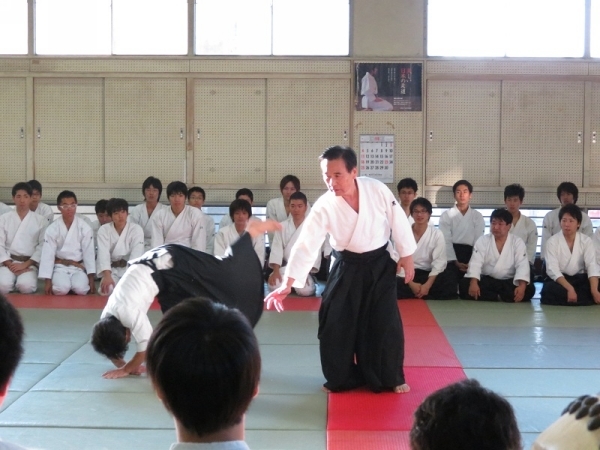
Eiichi Kuroiwa (黒岩 暎一) teaching Aikido at the Rikuryo Aikikai (六稜合氣会)
One of the articles that I have enjoyed reading the most was “Mr. Kimura’s Aikido Memories” (Part 1 | Part 2). Of course, the recollections of training with Aikido Founder Morihei Ueshiba in 1942 were fascinating, but much of what I appreciated about it was that it presented the perspective of an ordinary person encountering the Founder.
Here is another account along those lines – an account of training with the Founder, this time in the 1960’s, from an ordinary person. This is a brief collection of memories of his time with O-Sensei by Eiichi Kuroiwa, who trained with Morihei Ueshiba in Osaka for five years from 1963 to 1968. I hope that you enjoy it as much as I did!
 “Floating Bridge of Heaven” (天の浮橋) calligraphy by Seiseki Abe
“Floating Bridge of Heaven” (天の浮橋) calligraphy by Seiseki Abe
Aikido and Me – Training with the Founder
– by Eiichi Kuroiwa
My first encounter at Kitano High School and afterwards
(大阪府立北野高等学校 / Osaka Prefectural Kitano High School)
I’m certain that I remember being taught Aikido by (Seiseki) Abe Sensei when I was in my third year at Kitano High School.
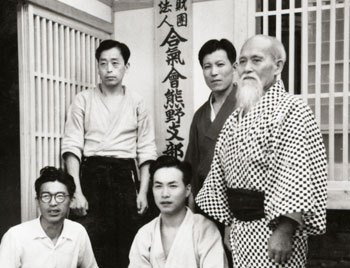 Seiseki Abe, standing far left, with Morihei Ueshiba
Seiseki Abe, standing far left, with Morihei Ueshiba
Kumano Juku, 1954
I was told “It’s not strength, it’s Ki”, and I thought that was quite mysterious. The round ukemi, silent like a cat, and so different from the loud vigorous “bam” “bam” of Judo ukemi, was very interesting to me. The next thing that I knew I had been enchanted by Aikido. We trained enthusiastically, and when I look at pictures of that time there were some ten or twenty people training. There were also a number of women.
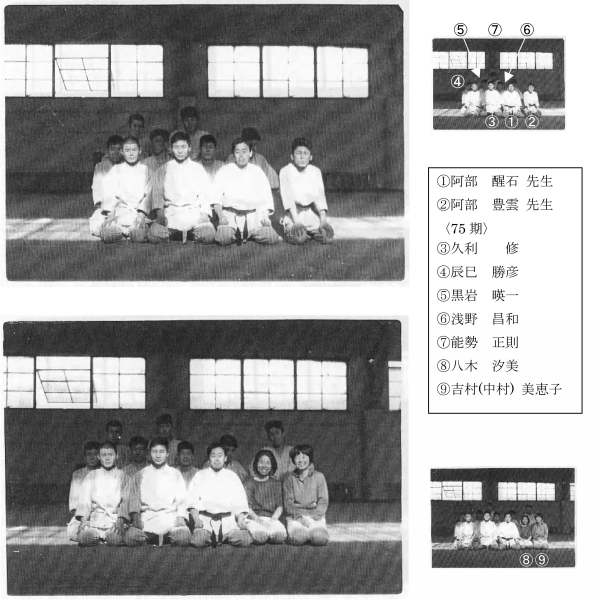 Kitano High School Gymnasium (Judo Dojo) around Showa 37 (1962)
Kitano High School Gymnasium (Judo Dojo) around Showa 37 (1962)
- Seiseki Abe Sensei (阿部 醒石)
- Houun Abe Sensei (阿部 豊雲 / son of Seiseki Abe)
- Osamu Kuri (久利 修)
- Katsuhiko Tatsumi (辰巳 勝彦)
- Eiichi Kuroiwa (黒岩 暎一)
- Masakazu Asano (浅野 昌和)
- Masanori Nose (能勢 正則)
- Kiyomi Yagi (八木 汐美)
- Mieko Yoshimura (Nakamura) (吉村(中村) 美恵子)
My classmate Mr. Katsuhiko Tatsumi from this period continued Aikido after high school, and opened his own dojo while working as a physician.
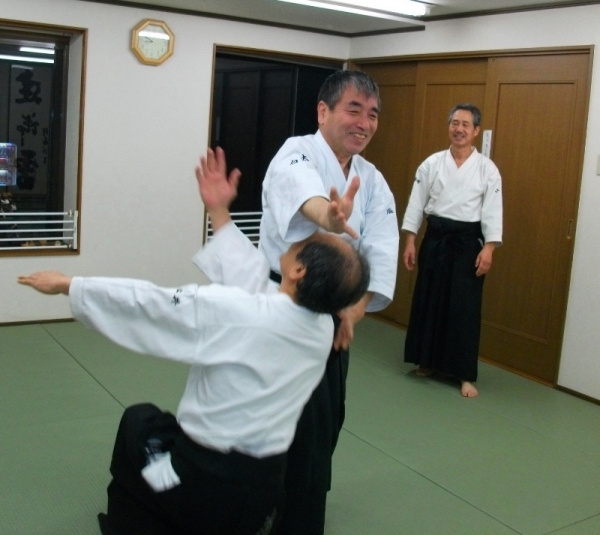 Aikido Hakutaikan (合氣道白太館) – Katsuhiko Tatsumi Kancho
Aikido Hakutaikan (合氣道白太館) – Katsuhiko Tatsumi Kancho
I had been under the impression that it was the Aikido Club, but when I look at the roster of the club it seems that this was before the formal establishment of the Aikido Club. Even so, I believe that the activity was formally acknowledged by the school. The reason that I can say that is that I remember performing in the “first demonstration” as one of the individual club activities at the school’s culture festival.
Since Abe Sensei built a dojo in his house, after I started college in Osaka I often went to his dojo in Suita.
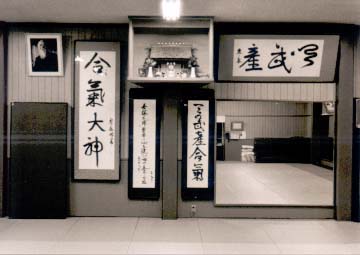 Amenotakemusujuku Aikido Dojo (天之武産塾合気道道場) in Suita City
Amenotakemusujuku Aikido Dojo (天之武産塾合気道道場) in Suita City
It was at this dojo in Suita City that I met Ueshiba Sensei. The presence of his appearance, the aura that he emitted, made a deep impact on me. Fortunately, at the time there were only beginners throughout the dojo, so I was able to receive instruction directly from Abe Sensei and Ueshiba Sensei. Once I became an adult I was chased by work and life, so I was not able to have much contact with Aikido. For exercise I wasn’t able to do more than some jogging when work allowed, but fortunately I was blessed with a healthy life.
After passing my sixtieth birthday I realized again the importance of one’s health. I thought about trying to do Aikido once more, but I had been apart from it for so many decades that I gave up that thought for a time. However, I thought it over and decided that I might just have enough time to start again, so I visited the Ofuna Aikido Kyokai / 大船合気道協会 (Shihan: Satoshi Takeda / 武田聡, 7th dan Aikikai) near my home (Kamakura-shi), and started again in August of 2008.
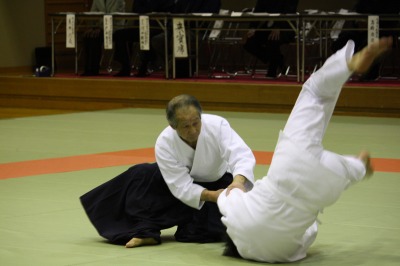 Satoshi Takeda (武田聡)
Satoshi Takeda (武田聡)
At that time Takeda Shihan said to me “I started Aikido after Ueshiba Kaiso passed away. There is hardly anyone left who received instruction from the Founder. Now that is an incredibly valuable experience. I’m envious.”, and I realized once again what an incredible experience I had been allowed.
Thanks to my training at Abe Sensei’s dojo in Suita City and with gratitude to O-Sensei, I received a shikishi (“colored paper” – a calligaphy paper). This precious shikishi has accumulated wrinkles and mold as it has passed through many long years, and I feel an unforgivable sense of wastefulness. Like the shikishi, if I were to keep the things that the Founder taught me to myself they would dissappear at some point in the future.
Therefore, I would like to take this opportunity to collect as much of what O-Sensei taught to me as possible. Memories of the deep gratitude accorded to the Founder by Abe Sensei to the instructor who taught him so thoroughly left a strong impression on me.
However, since I was a beginner at the time I think that there may have been things that were beyond my understanding, or that I have recalled incorrectly. I would be grateful if those reading this could help me to correct those errors.
I have paid particular attention to presenting the personage of O-Sensei that I saw and heard with my own eyes and ears and to presenting the instruction given to the beginners at the dojo.
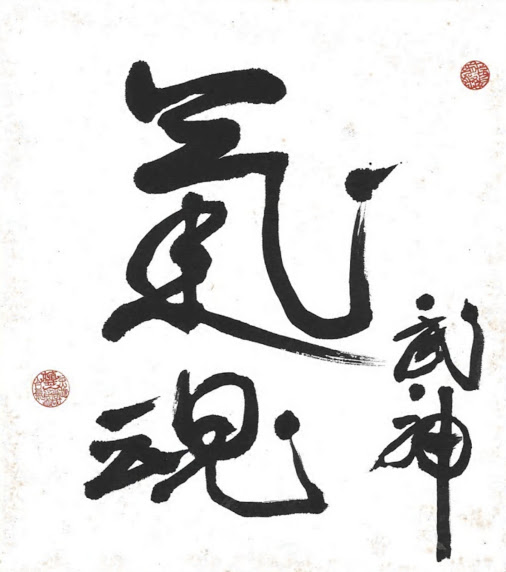
Shikishi (calligraphy card) received from O-Sensei in Showa 42 (1967)
氣魂 / “Kikon” / “Spirit” in the center, meaning the “ki” of the yo (yang)
“soul”, the soul associated with the intellect in other words, “intent”.
武神 / “Bushin” / “God of War” bottom right.
合気道は魂の学びである。 – “Aikido is the study of intent.”
– Aikido Founder Morihei Ueshiba
Things taught to me by O-Sensei
(the Founder, Morihei Ueshiba)
Morihei Ueshiba was born on December 14th 1883 in Tanabe City in Wakayama Prefecture. He passed away on April 26th 1969 (Showa 44). He was eighty-six years old at the time.
- Period of Instruction: 1963 (Showa 38) – March 1968 (Showa 43), for five years prior to his passing.
- Location: the Osaka dojo (Abe Shihan) – Ame-no-Takemusu Aiki Juku (天之武産合気塾), opened in Showa 38 (1963). The dojo name was given by O-Sensei. Also in the Osaka area were the dojo opened by Bansen Tanaka (Chairman of the Osaka Aikikai, passed away in 1988) in Showa 27 (1952) and the dojo opened by Michio Hikitsuchi in Showa 29 (1954) in Shingu City, Wakayama Prefecture.
- The setting for O-Sensei’s visits:
- He would visit and stay in Osaka and Wakayama in order to spread Aikido (I have heard that he would stay at Hikitsuchi Dojo for periods of a month at a time).
- Omoto-kyo: he would stay when he went to visit at Kameoka and Ayabe in Kyoto.
- Abe Shihan constructed a dojo adjacent to his home. Also, he constructed a new room in his home in to receive O-Sensei (it seems that he thought of Hikitsuchi Shihan and Abe Shihan in a special way. In later years both shihan received tenth dan certificates.).
- During his stay: He would accompanied by an uchi-deshi. We would receive direct instruction.
- He would always be accompanied by an attendant or an uchi-deshi.
- He would stary for a period of about one week to ten days.
Aikido instruction in the dojo
During the period of his stay O-Sensei would give direct instruction in the dojo. If O-Sensei had another engagement then there would be instruction from the uchi-deshi.
The uchi-deshi were overwhelmingly strong, and their instruction was something severe. The Osaka dojo had just been constructed and there were only beginners, but thanks to the strict training from the uchi-deshi I think that everybody was able to improve.
The uchi-deshi who seemed so incredible to our eyes would be handled like a child by O-Sensei, and we were once again able to see O-Sensei’s amazing strength with our own eyes.
Lectures in the dojo
Many people would come to visit when they heard that O-Sensei was staying in Osaka (they would just show up on their own).
“I want to get a look at the famous O-Sensei”, “I want to hear stories of his training” – people came with for a variety of reasons. One could tell at a glance that the people gathering all around were not ordinary people. I would listen to them chatting to each other before O-Sensei’s lectures began – there were Yamabushi (ascetic mountain hermits) from Nachi (Wakayama), budo-ka of considerable strength, religious figures and more.
O-Sensei knew that those kinds of people would show usually show up on their own, so in the evenings after training he would give lectures to the people who had gathered.
Lecture Content: details of O-Sensei’s shugyo period, the world of the Kojiki, training, etc. However, it was extremely high level for the beginners and young people like myself, very difficult to understand.
O-tomo: I acted as an o-tomo (attendant) for O-Sensei on two occasions.
I accompanied him to the Omoto-kyo compound (Kameoka). Then I accompanied him from the Omoto-kyo compound (Kameoka) back to the dojo in Suita.
The person who was originally scheduled to go had a scheduling conflict, and I was suddenly asked to take their place. Along the way we had many conversations. I met many people and had many experiences.
- The people weren’t ordinary in appearance, when I look back they were all people following a path.
- When they saw O-Sensei they would press their hands together and bow to him without thinking.
- O-Sensei was of advanced years, so climbing places like the stairs in the train stations was difficult. (I would push him up from behind)
- Just by acting as O-Sensei’s o-tomo I became stronger. When I trained after being an o-tomo I was told “You’re projecting a lot of Ki, you’re different than you usually are. What happened?”. (Abe Sensei taught me “The Ki emitted by O-Sensei is transferred. It happens to everybody.”)
- One of my classmates, Masakazu Asano, also acted as an o-tomo, and reported that he had the same experience.
- Unfortunately, after a week I would return to normal.
Training Trips: we travelled with introductions to Hombu Dojo, the Aiki Jinja and Kumamoto.
- I was able to be taught by Kisshomaru Hombu Dojo-cho, Saito Shihan (Aiki Jinja Dojo) and Sunadomari Shihan (Kumamoto).
- While on the training trips I realized that Abe Sensei’s “Go along with the flow of Ki (“Ki no nagare”)” was something special. Each dojo had it’s own particular characteristics, and I realized that everywhere was not uniform.
- Saito Shihan commented “You’re soft, as one would expect, since you’re being taught by Abe Sensei”.
The O-Sensei that I saw and heard with my own eyes and ears
O-Sensei’s appearance, daily and during training:
- A 153 centimeter (5′ 1/4″) older man. However, one could see at a glance that he didn’t have the appearance or look of an ordinary person.
- In any case, his piercing gaze was incredible, his aura was really incredible.
- When going out with him as an o-tomo people passing by would turn and look back. (some people would press their hands together and bow to him)
- He was a person for whom every day, the totality of his life, was conditioning (“tanren”).
The piercing gaze: everyday (yellow light), during training (white light). His everyday eyes and his eyes during training were different people’s eyes.
Dragon eyes (“ryugan” / 竜眼): a blue ring (his wife Hatsu also had the same dragon eyes)
Voice: It reverberated clearly. His Kiai was really incredible.
Dress: Haori, hakama, tabi, geta. He would always wear tabi during training. His belt was always fastened tightly. There was not a fingernail’s width between it and his body. (His attire was suitable for any time or for meeting any person.)
Stairs: It was difficult for him to climb the stairs himself at the train station (I would support him from behind and push on his hips. I was taught that this was Ki conditioning.) . He seemed like a different person than during training.
Shiatsu: He was happy when I gave him shiatsu on his back. It felt like pushing on an iron slab with my fingers. My fingers would bend back and forth. It wasn’t the back of a normal person. (I was taught that this was Ki conditioning.)
Bokken: He would always bring one. Perhaps it was handmade? Red oak (赤い樫)? (It was the color of a person while drinking alcohol.) His bokken would shine. He used it when he demonstrated or trained.
Jo: He would always bring one. He only used it for demonstrations or training about three times.
Spear: He didn’t bring one, but most of his lectures were about the spear.
Every morning: Cold water ablutions, and then chanting of Norito (祝詞 / Shinto prayers). After that, training, receiving guests, calligraphy.
Meals: Vegetarian. brown rice.
Training: Starting with Funa-kogi and Furi-tama. Oriented towards beginners. The uchi-deshi would take ukemi. Sometimes he would give demonstrations (bokken, jo, multiple attackers, Reppaku no Kiai)
Translator’s Note: “Reppaku no Kiai” (裂帛の気合), “ei”, the shout that cuts away barriers or impurities, and unites opposites.
8 millimeter film: When one saw him he moved slowly, as if he were dancing. The projected films seem as if they are time lapsed.
Hands: When he touched you it felt as if it were the hands of the Kami. It was a mysterious sensation.
O-Sensei’s Lectures
Many people (budo-ka and others) would hear rumors of O-Sensei’s stay and begin to gather. Although nobody had notified them, they would just show up on their own (they couldn’t be turned away). Mostly, he would speak to the people who had gathered after training had finished – “A lot of people are here, what would you like to do?” “They must want to listen to this old man again…”.
Also, during his stay he would talk to the young people – “I enjoy speaking to young people.”. He’d speak about his early life, his training, Omoto-kyo, the Kojiki, enlightenment, comments to society, etc.
Lectures that made an impression
O-Sensei really spoke about a lot of things. Unfortunately, I was a beginner and many things were beyond my understanding. Even so, I remember a few lectures that reflected the essence of Aikido.
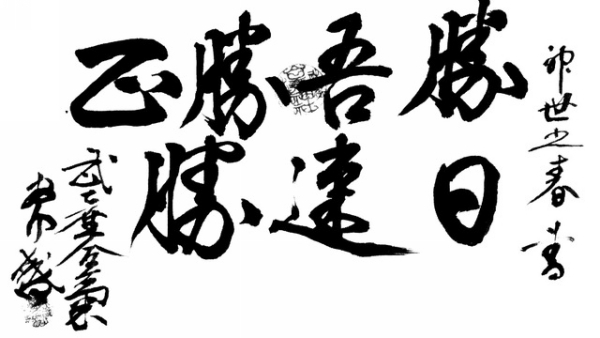 Masakatsu Agatsu Katsuhayabi (正勝吾勝勝速日)
Masakatsu Agatsu Katsuhayabi (正勝吾勝勝速日)
Calligraphy by Aikido Founder Morihei Ueshiba
The Secret of Aikido: “The secret of Aiki is Masakatsu Agatsu Katsuhayabi” (合気の極意は、正勝吾勝勝速日なり)
- Masakatsu (正勝): The person with the correct spirit will be victorious (正しい心の人が勝つ)
- Agatsu (吾勝): If one can be victorious over themselves then they can also be victorious over others (自分に勝てれば他人にも勝てる)
- Katsuhayabi (勝速日): Victory with the speed of light (speed, do not be lazy) (日の速さに勝つ (スピード、怠けない)
Aikido conditioning: Why do we do Aiki?
 Calligraphy by Seiseki Abe – Gan-Sa-Tan-Riki
Calligraphy by Seiseki Abe – Gan-Sa-Tan-Riki
眼(がん)、作(さ)、胆(たん)、力(りき)
“Aiki is something for conditioning human beings. It is Gan Sa Tan Riki (眼作胆力)”
- Riki (力): No matter how much one trains their physical strength there is a limit, they cannot fight oppose one who has trained their “Tanryoku” / 胆力 (“Ki”).
- Sa (作): Even if one trains their physical strength, they will be thrown easily by one who trains their technique (“Sa” / 作 – “waza”). (However, technique must have contact with the opponent.)
- Tan (胆): A person who trains their Ki, trains their strength, and masters technique (“Sa”) can throw independently from the opponent. “It’s water and fire (“Iki”)!” (水火(いき)じゃよ。)
- Gan (眼): However, however much one trains their strength, masters technique, or trains their Ki, they will be thrown at a single glace by one who was trained their eyes (眼). “I immobilize an opponent with my eyes.”
Translator’s note: Tokimune Takeda’s personal notes of his training with his father Sokaku Takeda make several mentions of the importance of training the eyes.
“Aikido is something for training human beings.”
Training partners: “I don’t use human beings for partners, the universe is my partner. It’s not a battle, I train to become one with the universe.”
Kojiki: All of the secrets of Aikido appear in the Kojiki. The Kojiki points to many truths through things such as the names of the Kami. These are different from the names of the gods in the West.
The secret of Aikido: Masakatsu-Agatsu Katsu-Hayabi-Ame-no-Oshi-Ho-Mimi-no-mikoto. (正勝吾勝勝速日天之忍穂耳命) Translator’s note: The child of Susanoo and Amaterasu, who would become the ancestor of the Japanese imperial line.
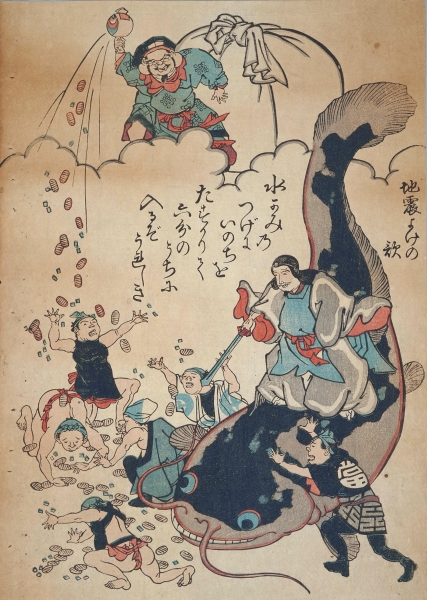 Takemikazuchi-no-kami subduing the earthquake (the catfish)
Takemikazuchi-no-kami subduing the earthquake (the catfish)
Woodblock print from 1855
The application of Aikido technique: Takemikazuchi-no-kami (建御雷神)
“When one takes this hand it is as if it is covered in ice, then covered with the blade of a sword.” – Meaning that when Takemikazuchi-no-kami puts Ki into the hand, it is as if it is covered with ice, then it becomes like the blade of a sword.
“When one takes the opponent’s hand, grasp and break them (crush them) like taking a reed, then throw them away… “ – Meaning to put Ki into one’s hand when they grasp the hand of the opponent (Yonkyo), and then throw them away.
Translator’s note: Takemikazuchi, also known as “Kashima-no-kami” was a god of swords and thunder that was said to have participated in the first recorded Sumo match in the Kojiki. Interestingly, Sokaku Takeda cited this match as the origin of Daito-ryu Aiki:
Aiki is said to have originated in the ancient art of tegoi, which is mentioned in an ancient Japanese myth about two gods, Takemikazuchi no Kami and Takeminakata no Kami. Recorded in Japan’s oldest written document, the Kojiki, (Records of Ancient Matters, compiled around 712 AD), this story recounts how Takemikazuchi no Kami took the hands of Takeminakata no Kami and “as if he had taken hold of a reed, squeezed his hands and threw him.”
Tajikara-o no Mikoto (太力男命): Open the stone door of heaven (incredible power)
Everybody posseses great strength: Like Kajiba no Kuso Djikara (“Burning Inner Strength” / 火事場のクソ力) – latent power that emerges during a great dilemma. This isn’t normally available. To condition oneself so that it is normally available is Aikido.
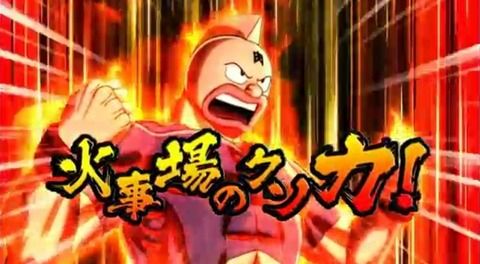 “Burning Inner Strength” – from the Manga “Kinnikuman” (キン肉マン)
“Burning Inner Strength” – from the Manga “Kinnikuman” (キン肉マン)
In his youth nobody could best him in contests of strength. In the sea at the edge of the rice fields of his home town there was a foreign ship that came and caught a whale. That ship came to shore to get refresh their supply of water. They loaded barrels of water into sculling boats (伝馬船) and took them out to the ships anchored at sea. He would lift up the barrels easily and pass them up to the sailors, but they were surprised at the weight and had to use a crane to receive them.
He learned Budo from the Daito-ryu instructor Sokaku Takeda (he’d be told how much to pay for each technique, and used up quite a bit of money), and at the time that he had become an exceptional budo-ka he encountered Onisaburo Deguchi and entered Omoto-kyo. Then Onisaburo Deguchi drew out his true strength.
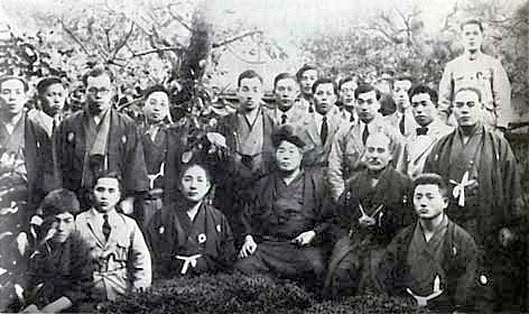 Morihei Ueshiba and Onisaburo Deguchi, around 1933
Morihei Ueshiba and Onisaburo Deguchi, around 1933
The two miracles of Omoto-kyo
Everyone was out in the garden, when Onisaburo Deguchi suddenly spoke to him:
“Ueshiba-san, Ueshiba-san, you can uproot that pine tree.”
“Ueshiba-san, Ueshiba-san, you can lift up that large stone.”
“At the moment that he spoke to me my body became bright red and incredible strength welled forth. Then I uprooted the pine tree and lifted the large stone.”
- Onisaburo Deguchi was able to see the strength that he had been unaware of.
- It’s not that he believed in Omoto-kyo, but because he felt an obligation he continued to attend their ceremonies even until that time.
“The strength of Aiki is an incredible power, like the gravity of the Earth. It exists naturally. Just lifting a bucket of water is difficult. The earth supports the water of the vast oceans. Where does that power come from? It is in the center of the Earth. What is in the center of the earth? There is nothing material there. Gravity is created from a place where there is nothing. Actually, it isn’t nothing, it’s something (“nothingness is substance” / 無即有). This power that is like gravity is the Ki of Aiki.”
Teaching Beginners
We beginners were taught Ikkyo, Nikyo, Sankyo, Yonkyo, Shiho-nage, Irimi-nage, Tenchi-nage, Kote-gaeshi, Ushiro-dori, Kokyu-nage and other basic forms. Additionally, the following instruction left a deep impression – immovable posture…hanmi with ma-ai, immovable like a boulder. Then respond to the partner’s movement.
How to Put in Ki
If one is conscious of the flow of Ki then it will flow. When Ki flows the arm becomes unbendable without putting in strength. The opponent will move in accordance with the flow of Ki from one’s fingertips.
- Bend in the direction of the bend. Aikido does not bend the joint backwards.
- There is no kicking.
- Match without fighting.
- Condition oneself daily. There is training and there is refining.
- What would you do if you were thrown on concrete? (ukemi that makes a loud noise is no good)
- Kana-shibari no Jutsu (金縛りの術) – spirit binding techniques.
- This is a Budo of the spear (point) rather than the sword (line)
- Don’t leave the other hand behind.
- Harmonize with Heaven and Earth, practice with the intent of harmonizing with the Universe.
- Funakogi (Ki training: e/ho and e/sa), Furitama (achieve Mushin)
A Close Friend Becomes an Uchi-Deshi
They came from the Shingu Dojo to Osaka on training trips. Since we were of similar ages we would train together. Then they became an uchi-deshi. About six months later they came to the Osaka Dojo as an o-tomo to O-Sensei, where we met again and trained together.
They had become incredibly strong.
“How much time do the uchi-deshi spend training?”
“Apart from the regular clases, we train with Doshu and the other uchi-deshi everyday. However, just for about 15 minutes at a time. It’s not a kind of training that one can do for longer than that.”
“What kind of training is only for 15 minutes?”
“It’s hard to put into words.”
“You’ve gotten incredibly strong, I was really surprised.”
“…I’m surprised to hear that. This is the first time since I’ve been an uchi-deshi that I trained with someone from outside. I had a vague feeling that I was different than I was before. I’m happy to hear that I’ve gotten stronger.”
Kisshomaru Ueshiba Sensei: I received instruction from him on a training trip to Aikikai Hombu Dojo. When my wrist was taken by Kisshomaru Waka Sensei I couldn’t move my body.
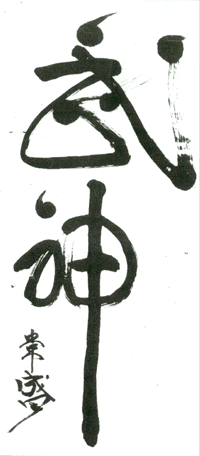 “Bushin” (武神) – “God of War”
“Bushin” (武神) – “God of War”
Calligraphy by Aikido Founder Morihei Ueshiba
O-Sensei and Calligraphy: He would write continuously from start to finish – “I want to communicate through the calligraphy.”
When I was promoted to san-dan I received the shikishi from him – “In thanks for your hard work when you attended me in Kameoka.”
Conclusion
During the time that I received instruction from O-Sensei I was a student majoring in electrical engineering. In a normal way of thinking Aikido and electrical engineering are unrelated and very far apart. Partially because of that my student friends of the time would often question me.
“You do Aikido enthusiastically, what’s the difference between Aikido and Judo?”
When I answered them in the following way they were able to understand:
“Judo is the world of Newtonian physics. In contrast, Aikido is the world of quantum mechanics. “
Judo
- Founder: Jigoro Kano (嘉納治五郎)
- Scientific
- Philosophical
- “Softness overcomes hardness”
- Use the opponent’s strength
- Train your strength
- Make contact with the opponent and apply technique
- Can be seen with the eyes
- Can be understood with the mind
- Newtonian physics
Aikido
- Founder: Morihei Ueshiba (植芝盛平)
- Mysterious
- Religious
- Harmonize with the opponent
- Harmonize Ki
- Draw forth Ki (that one already posseses)
- Apply technique independently from the opponent (Ki)
- Cannot be seen with the eyes
- Cannot be understood with the mind
- Quantum mechanics
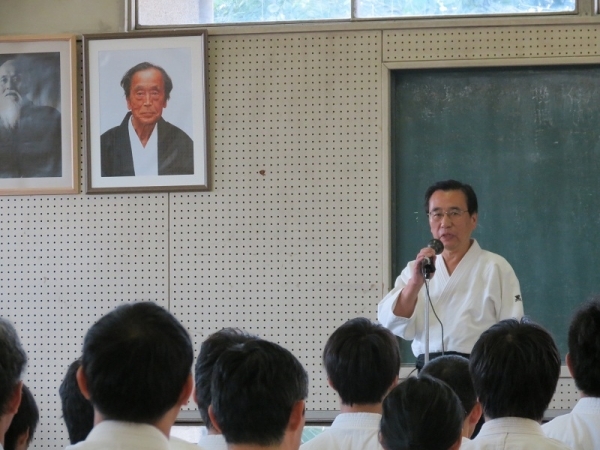
Published by: Christopher Li – Honolulu, HI
All of the content on this site is, and will continue to be, provided free of charge as a service to the community. You can help support this project by contributing a little bit to help support our efforts. Every donation (even $1) is greatly appreciated and helps to cover our server and bandwidth costs, and the time involved. The more support that we get the more interesting new content we can get out there!
By donating you also help support our efforts at Aikido Hawaii, which has provided a state-wide resource for all Aikido in Hawaii, regardless of style or affiliation, for almost twenty years.
Thank you for your support and encouragement,
Chris

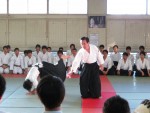
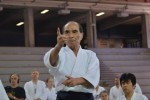
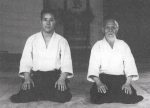
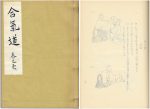
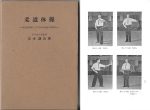
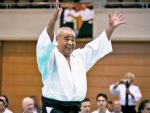
Thank you, Chris.
Again an important read.
May be OSensei brought his otomo and uchi deshi because he didn’t see any point in wasting this nurishing effect, through being able to touch him directly or being thrown by him, like spraying water indiscriminately and risking to make the wrong people stronger. Sagawa, too, according to Kimura was very careful about this nurishing effect, consciously waiting for month or even years before touching and making stronger a disciple.
Best,
Bernd
Glad that you enjoyed it Bernd! Quite a lot of interesting bits in this one, I thought.
Best,
Chris
As a late student of Abe Sensei, this is a fascinating look back at the earliest years of his aikido organization if you could call it that. I always got the feeling Abe Senseis group centered on the aikido club of Kitano High School in Osaka where he had been a calligraphy teacher for almost 50 years. Bansen Tanaka and Hirokazu Kobayashi (both of whom were close friends of Abe Sensei) seemed to be the mainstays in Kansai during the Post War Era. Wheras the two groups were the result of their efforts to build organizations, Abe Sensei’s group grew AROUND him due to alumni from Kitan High. Amazing!
Thank you for the information you gather and share. I share your articles to our schools page. They are so insightful.